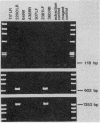Abstract
Specific and sensitive amplification of major outer membrane protein (MOMP) gene DNA sequences of Chlamydia psittaci was achieved in a two-step polymerase chain reaction. First, oligonucleotide primers specific for 5' and 3' nontranslated regulatory regions of the MOMP gene were used in a polymerase chain reaction to amplify a DNA fragment of approximately 1,400 bp. A portion of this DNA fragment was amplified in a second reaction using a degenerate oligonucleotide primer specific for a DNA sequence contained within the 1,400-bp DNA fragment and one of the first-step primers. This method detected 10 cognate chlamydial genomes. C. psittaci MOMP genes from two avian strains and from mammalian serovars 1, 7, and 8 were amplified and analyzed by restriction endonuclease digestion. MOMP genes from mammalian serovars 2 through 6 and 9 and from strains of C. trachomatis and C. pneumoniae could not be amplified. Restriction endonuclease analysis with HaeIII indicated a close relationship between C. psittaci strains of avian and mammalian serovar 1 lineage, while those of mammalian serovars 7 and 8 exhibited distinct restriction patterns. DNA sequences corresponding to the mammalian serovar 1-wild type parakeet MOMP genotype of C. psittaci were detected in two of seven milk samples from cases of bovine mastitis.
Full text
PDF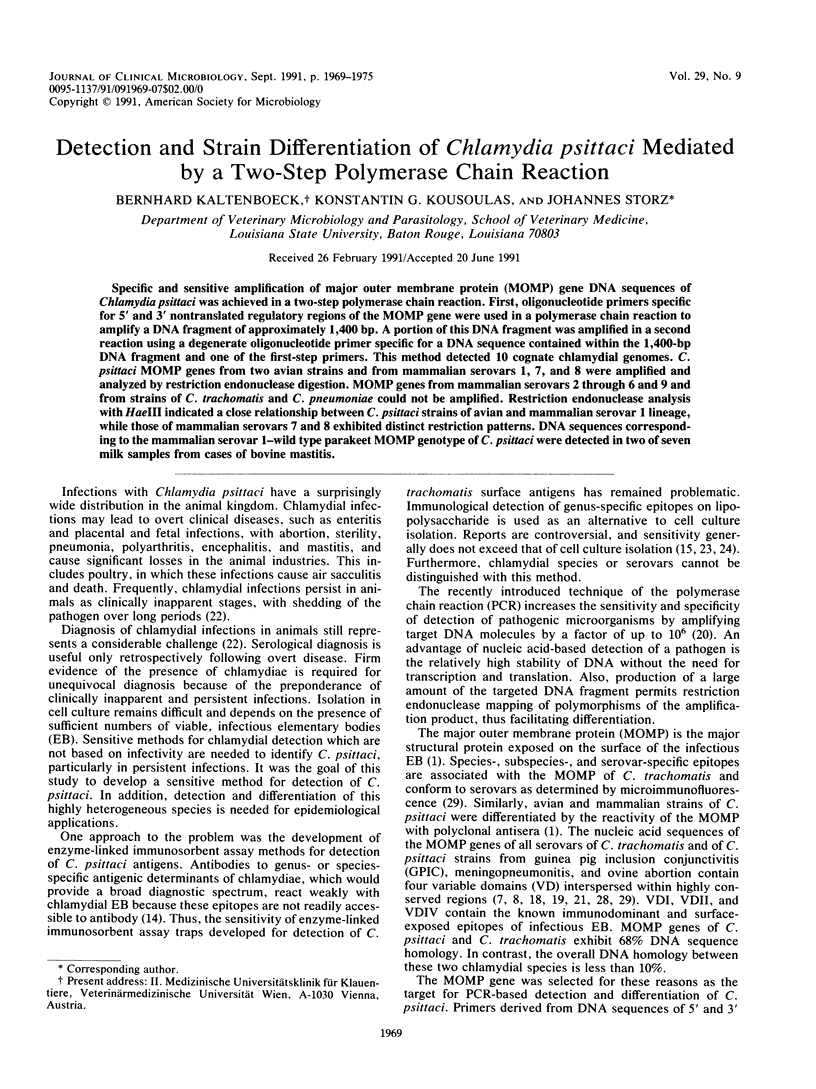
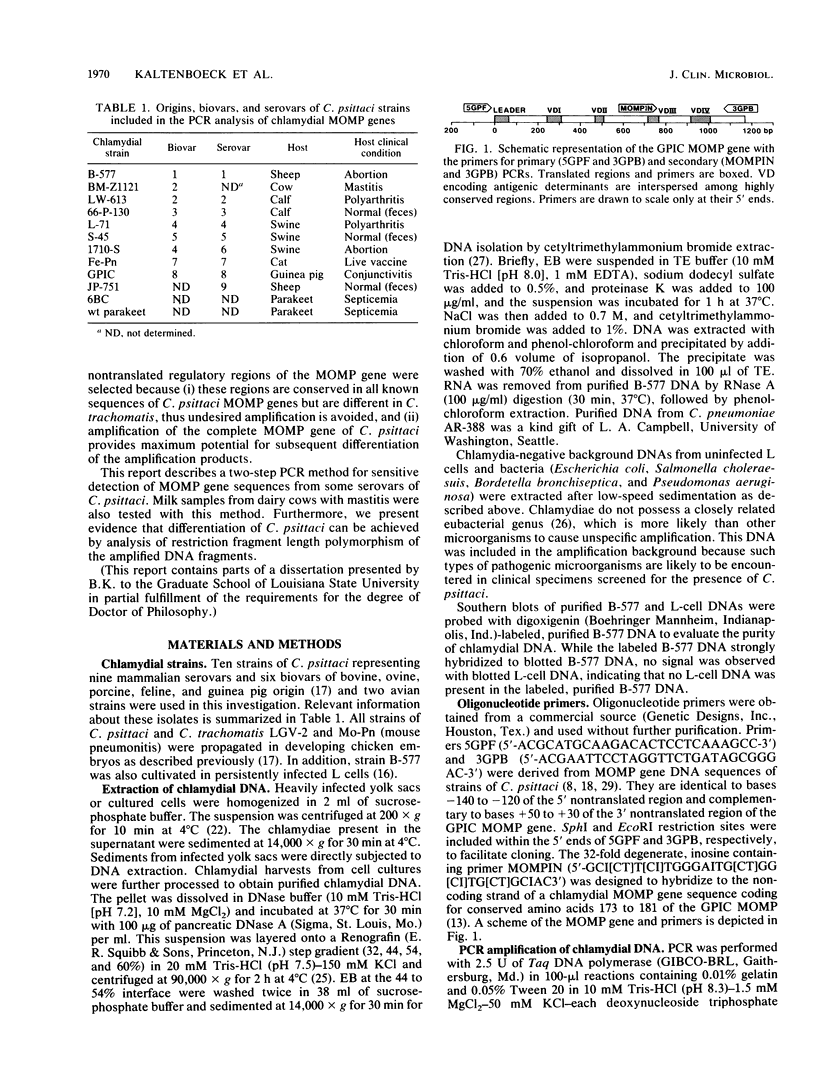
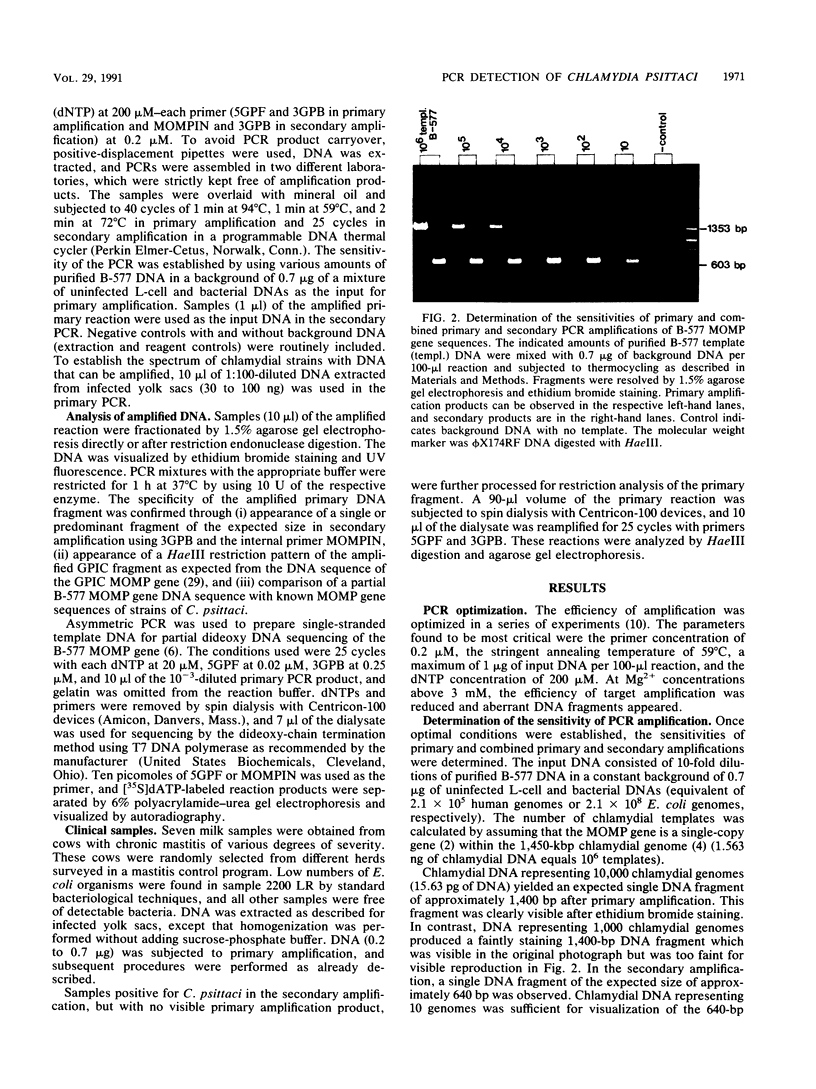

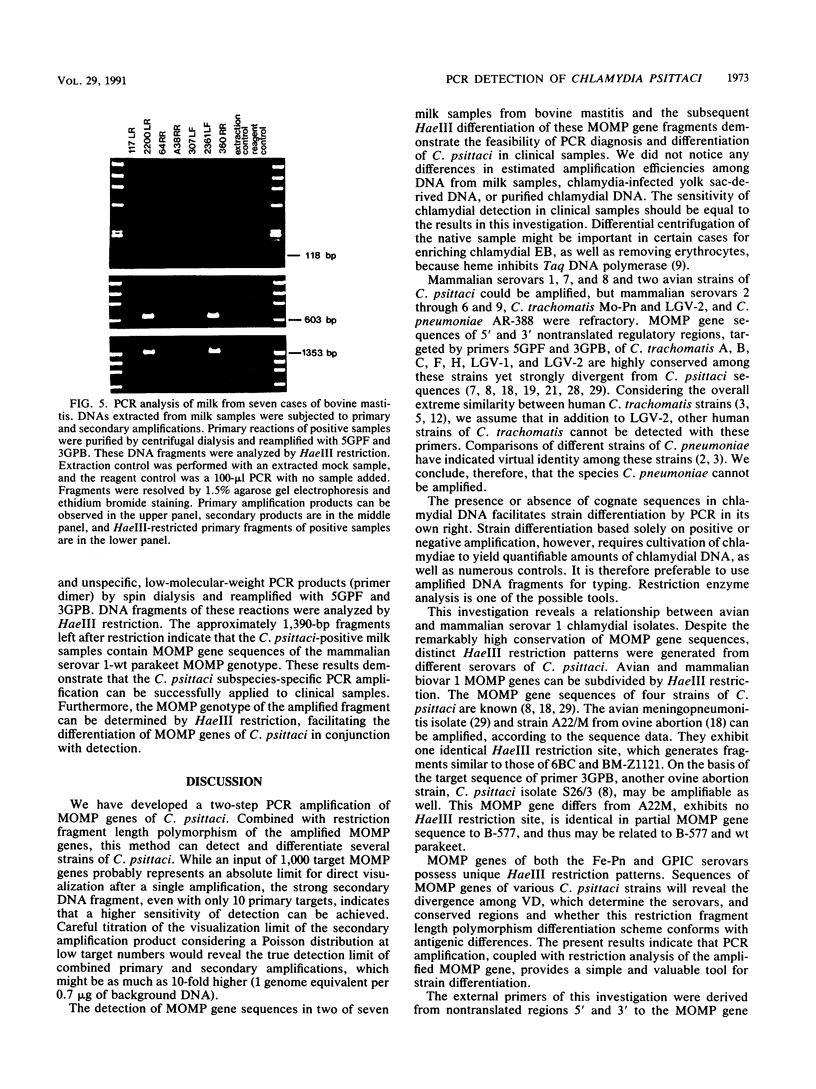

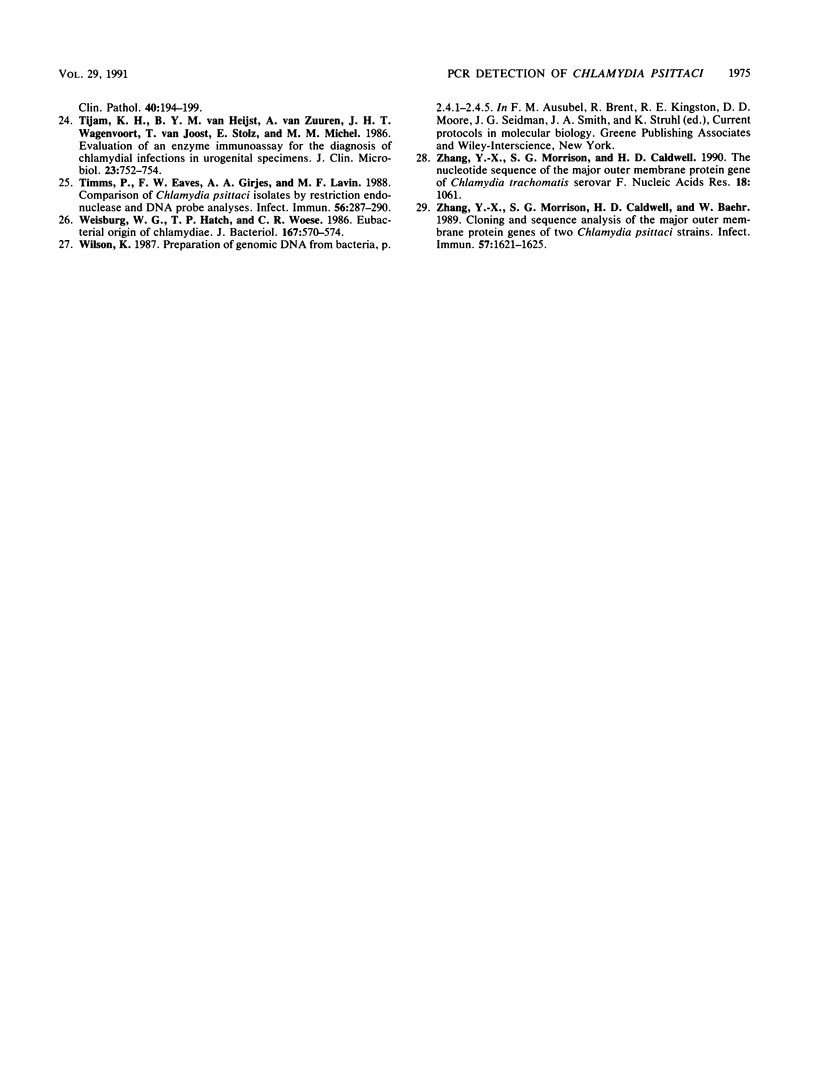
Images in this article
Selected References
These references are in PubMed. This may not be the complete list of references from this article.
- Baghian A., Shaffer L., Storz J. Antibody response to epitopes of chlamydial major outer membrane proteins on infectious elementary bodies and of the reduced polyacrylamide gel electrophoresis-separated form. Infect Immun. 1990 May;58(5):1379–1383. doi: 10.1128/iai.58.5.1379-1383.1990. [DOI] [PMC free article] [PubMed] [Google Scholar]
- Campbell L. A., Kuo C. C., Grayston J. T. Characterization of the new Chlamydia agent, TWAR, as a unique organism by restriction endonuclease analysis and DNA-DNA hybridization. J Clin Microbiol. 1987 Oct;25(10):1911–1916. doi: 10.1128/jcm.25.10.1911-1916.1987. [DOI] [PMC free article] [PubMed] [Google Scholar]
- Frutos R., Pages M., Bellis M., Roizes G., Bergoin M. Pulsed-field gel electrophoresis determination of the genome size of obligate intracellular bacteria belonging to the genera Chlamydia, Rickettsiella, and Porochlamydia. J Bacteriol. 1989 Aug;171(8):4511–4513. doi: 10.1128/jb.171.8.4511-4513.1989. [DOI] [PMC free article] [PubMed] [Google Scholar]
- Fukushi H., Hirai K. Genetic diversity of avian and mammalian Chlamydia psittaci strains and relation to host origin. J Bacteriol. 1989 May;171(5):2850–2855. doi: 10.1128/jb.171.5.2850-2855.1989. [DOI] [PMC free article] [PubMed] [Google Scholar]
- Gyllensten U. B., Erlich H. A. Generation of single-stranded DNA by the polymerase chain reaction and its application to direct sequencing of the HLA-DQA locus. Proc Natl Acad Sci U S A. 1988 Oct;85(20):7652–7656. doi: 10.1073/pnas.85.20.7652. [DOI] [PMC free article] [PubMed] [Google Scholar]
- Hamilton P. T., Malinowski D. P. Nucleotide sequence of the major outer membrane protein gene from Chlamydia trachomatis serovar H. Nucleic Acids Res. 1989 Oct 25;17(20):8366–8366. doi: 10.1093/nar/17.20.8366. [DOI] [PMC free article] [PubMed] [Google Scholar]
- Herring A. J., Tan T. W., Baxter S., Inglis N. F., Dunbar S. Sequence analysis of the major outer membrane protein gene of an ovine abortion strain of Chlamydia psittaci. FEMS Microbiol Lett. 1989 Nov;53(1-2):153–158. doi: 10.1016/0378-1097(89)90383-2. [DOI] [PubMed] [Google Scholar]
- Kaneko S., Feinstone S. M., Miller R. H. Rapid and sensitive method for the detection of serum hepatitis B virus DNA using the polymerase chain reaction technique. J Clin Microbiol. 1989 Sep;27(9):1930–1933. doi: 10.1128/jcm.27.9.1930-1933.1989. [DOI] [PMC free article] [PubMed] [Google Scholar]
- Kingsbury D. T., Weiss E. Lack of deoxyribonucleic acid homology between species of the genus Chlamydia. J Bacteriol. 1968 Oct;96(4):1421–1423. doi: 10.1128/jb.96.4.1421-1423.1968. [DOI] [PMC free article] [PubMed] [Google Scholar]
- Knoth K., Roberds S., Poteet C., Tamkun M. Highly degenerate, inosine-containing primers specifically amplify rare cDNA using the polymerase chain reaction. Nucleic Acids Res. 1988 Nov 25;16(22):10932–10932. doi: 10.1093/nar/16.22.10932. [DOI] [PMC free article] [PubMed] [Google Scholar]
- Kuo C. C., Chi E. Y. Ultrastructural study of Chlamydia trachomatis surface antigens by immunogold staining with monoclonal antibodies. Infect Immun. 1987 May;55(5):1324–1328. doi: 10.1128/iai.55.5.1324-1328.1987. [DOI] [PMC free article] [PubMed] [Google Scholar]
- Mabey D. C., Robertson J. N., Ward M. E. Detection of Chlamydia trachomatis by enzyme immunoassay in patients with trachoma. Lancet. 1987 Dec 26;2(8574):1491–1492. doi: 10.1016/s0140-6736(87)92623-7. [DOI] [PubMed] [Google Scholar]
- Perez-Martinez J. A., Storz J. Antigenic diversity of Chlamydia psittaci of mammalian origin determined by microimmunofluorescence. Infect Immun. 1985 Dec;50(3):905–910. doi: 10.1128/iai.50.3.905-910.1985. [DOI] [PMC free article] [PubMed] [Google Scholar]
- Perez-Martinez J. A., Storz J. Persistent infection of L cells with an ovine abortion strain of Chlamydia psittaci. Infect Immun. 1985 Nov;50(2):453–458. doi: 10.1128/iai.50.2.453-458.1985. [DOI] [PMC free article] [PubMed] [Google Scholar]
- Saiki R. K., Gelfand D. H., Stoffel S., Scharf S. J., Higuchi R., Horn G. T., Mullis K. B., Erlich H. A. Primer-directed enzymatic amplification of DNA with a thermostable DNA polymerase. Science. 1988 Jan 29;239(4839):487–491. doi: 10.1126/science.2448875. [DOI] [PubMed] [Google Scholar]
- Stephens R. S., Sanchez-Pescador R., Wagar E. A., Inouye C., Urdea M. S. Diversity of Chlamydia trachomatis major outer membrane protein genes. J Bacteriol. 1987 Sep;169(9):3879–3885. doi: 10.1128/jb.169.9.3879-3885.1987. [DOI] [PMC free article] [PubMed] [Google Scholar]
- Timms P., Eaves F. W., Girjes A. A., Lavin M. F. Comparison of Chlamydia psittaci isolates by restriction endonuclease and DNA probe analyses. Infect Immun. 1988 Jan;56(1):287–290. doi: 10.1128/iai.56.1.287-290.1988. [DOI] [PMC free article] [PubMed] [Google Scholar]
- Tjiam K. H., van Heijst B. Y., van Zuuren A., Wagenvoort J. H., van Joost T., Stolz E., Michel M. F. Evaluation of an enzyme immunoassay for the diagnosis of chlamydial infections in urogenital specimens. J Clin Microbiol. 1986 Apr;23(4):752–754. doi: 10.1128/jcm.23.4.752-754.1986. [DOI] [PMC free article] [PubMed] [Google Scholar]
- Weisburg W. G., Hatch T. P., Woese C. R. Eubacterial origin of chlamydiae. J Bacteriol. 1986 Aug;167(2):570–574. doi: 10.1128/jb.167.2.570-574.1986. [DOI] [PMC free article] [PubMed] [Google Scholar]
- Zhang Y. X., Morrison S. G., Caldwell H. D., Baehr W. Cloning and sequence analysis of the major outer membrane protein genes of two Chlamydia psittaci strains. Infect Immun. 1989 May;57(5):1621–1625. doi: 10.1128/iai.57.5.1621-1625.1989. [DOI] [PMC free article] [PubMed] [Google Scholar]
- Zhang Y. X., Morrison S. G., Caldwell H. D. The nucleotide sequence of major outer membrane protein gene of Chlamydia trachomatis serovar F. Nucleic Acids Res. 1990 Feb 25;18(4):1061–1061. doi: 10.1093/nar/18.4.1061. [DOI] [PMC free article] [PubMed] [Google Scholar]






